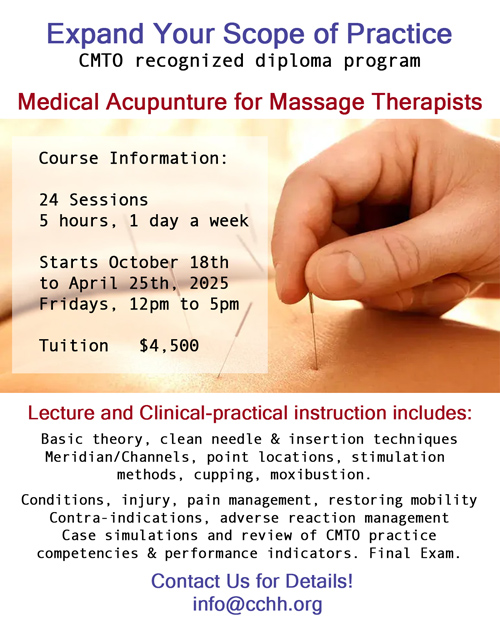
Acupuncture Practitioner
ACUPUNCTURE &
MOXIBUSTION
Course Outline (CCHH1402)
Total Hours: 210
hours is allocated for theory and clinical practice in the College clinic.
Prerequisite:
Knowledge of Anatomy and Physiology, RMT/ Health Professional/ Science degree
Lectures: Held 6 hours once per week. Classes will include review, theory,
protocols and acupuncture practice.
Professor: Prof. Sohrab Khoshbin, Ph. D. Office 905 884 9141 Email: drkhoshbin@cchh.org
Method of
Instruction: Lecture,
Demonstration, Hands-on practice, Individual presentation, and patient case
simulation, Final Exam.
Learning
Objectives and Outcomes:
Basic Theory: Knowledge of Acupuncture Meridians,
Point locations, Needling techniques, Moxibustion, Cupping; Basic Auricular,
and other integrative acupuncture modalities and techniques; provincial
regulations and the law concerning the practice of Acupuncture.
Competency: of Medical Acupuncture point
prescription protocols; Hands-on
treatments / Practical competency; Clean
needle techniques.
- Philosophy of TCM
- History of Chinese Acupuncture & Moxibustion
- Yin – Yang & Theory
of Five Elements
- The Meridians & Collaterals
- Medical Terminology
- Introduction to Acupuncture & Moxibustion
- Oriental Theory & Treatment of Disease
- Methods of Locating Points
- Acupuncture Techniques
- The Zang – Fu organs
- Qi, Blood & Body Fluid
- Needling Technique
- Electrical Acupuncture
- Caution & Contraindications
- Internal Medicine
- Cupping & Moxibustion
- Assessment Methods of TCM
- Pulse & Tongue Diagnosis
- Pain Management and Stress Relief
- Scalp Acupuncture
- Ear or Auricular Acupuncture
- Treatment of Common Diseases
- Oriental Treatment of Disease
- Breathing Techniques
- Public Health
- Safe Needle Techniques
- Introduction to the College of Traditional Medicine Practitioners
and Acupuncturists of Ontario
- Professional Standards and the Law, RHPA, TCMA
- Business affairs and Ethics,
- Inter-professional Collaboration;
RMT Scope of Practice, Harm Clause, Title Protection
- Provincial Regulation,
Patient Records, Informed Consent
- Clinical Work & Case Study
- Final Examination
- Evaluation Review and Summary
Textbooks,
Needles and Equipment:
Pictorial Atlas of Acupuncture: An Illustrated Manual of Acupuncture
Points. Authors: Michael Hammes,
Dr. Bernard C. Kolster, Yu-Lin Lian, Dr. Chun-Yan Chen. Edited by Hans P. Ogal and Wolfram Stor. H.F. Ullman, Publishing, New York, 2012.
Color Atlas of Acupuncture: Body Points – Ear Points – Trigger
Points. Authors: Hans-Ulrich Hecker, Angelika
Steveling, Elmar Peuker, Joerg Kastner, Kay Liebchen. Theime, New York, 2008.
Jurisprudence Course Handbook: Important Legal Principles
Practitioners Need to Know. Richard Steinecke. College of Traditional
Chinese Medicine Practitioners and Acupuncturists of Ontario. Toronto. 2012.
Safety Program for Traditional Chinese Medicine Practitioners and
Acupuncturists. College of Traditional
Chinese Practitioners and Acupuncturists of British Columbia and College of
Traditional Chinese Medicine Practitioners and acupuncturists of Ontario.
September 2012.
Additional handouts and notes will be distributed.
Upon successful completion of this course, students will be awarded
a diploma in acupuncture. They are eligible for registration with the Ontario
Council of Acupuncture & Chinese Medicine and the College of Traditional
Chinese Medicine Practitioners and Acupuncturists of Ontario. Membership in these associations entitles the
graduates to use the suffix C.Ac. and to
obtain the required liability insurance for their practice. Completion also
qualifies for recognition by the CMTO of 102 Category A CEU’s.
For more information please contact us.